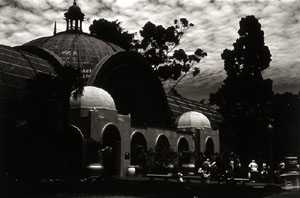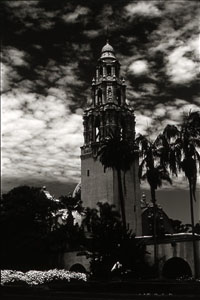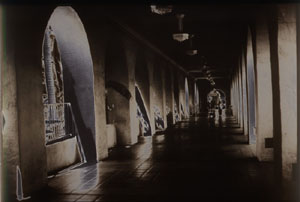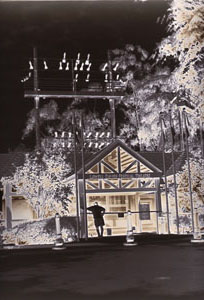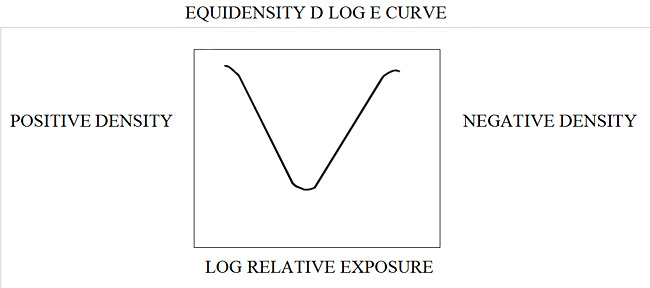 |
|||
|
|
|
Eastman High Contrast Panchromatic Film 5369 by Harvey W. Yurow Ph.D. Background: As the 35mm bulk rolls of Kodak Technical Pan 2415 film (production discontinued 2003) wind down, the question arises as to whether any currently produced offering approximates the unique characteristics of this black–and-white film? Technical Pan belongs to a group of films produced in 35mm format and having ultrahigh resolution. This property is the result of a monodisperse emulsion having extremely small silver halide grains, which goes hand in hand with high contrast. High contrast films are of three general types: 1.) moderately high contrast, i.e., gamma range of 2.5-3.5, with panchromatic sensitivity, including Technical Pan, 2.) gamma range of 2.5-4.5, with only blue sensitivity, such as Eastman Fine Grain Release Positive Film, used to prepare positive motion picture prints, 3.) Lithographic films of gamma around 9, either orthochromatic or panchromatic, including Kodak Ektagraphic HC Slide Film for making title slides. However, it should be pointed out that Technical Pan differs in degree from all of the others in two respects – its speed is considerably faster, to allow for pictorial photography at lower contrasts, and probably involves organic chemical supersensitizers (APUG), and it has extended red sensitivity. This film replaced two others, Kodak Solar Flare Patrol Film SO-392, with maximum sensitivity in the region of the hydrogen-alpha line at 656nm, and Kodak Photomicrography Monochrome Film SO-410, used for photography through a microscope, where specimens are often of low contrast (Kodak 1977). Possible replacements for Technical Pan with regard to two unusual uses of interest, i.e., equidensity technique and reversal development (see below) should have the following parameters:
A second film tested by Everhart, and considered here, was Kodak Recordak AHU Microfilm 1460, its current incarnation being Kodak Imagelink HQ Microfilm. As compared to Eastman 5369, speed, contrast, and red sensitivity are similar (Kodak 2009), but maximum density is considerably less (2.1). Similarly, Eastman Panchromatic Separation Film 2238, another cinematographic intermediate film, has a suitable D max, (>3.0), but maximum gamma of only 1.8. Eastman High Contrast Panchromatic Film 5369, introduced in 1973 and formerly known as SO-389 (Anon 1973), is available in 35mm as 1000' rolls ($232) from the Kodak Motion Picture Film Hollywood Regional Center (1-800-621-3456) . This large roll can be rewound by hand onto 100' metal spools, such as Kodak S-83, for use in 35mm bulk film loaders. The procedure is somewhat lengthy in a changing bag, but considerably less so in a completely black darkroom where the large bulk roll can be supported vertically so as to freely rotate, with the metal uptake spool also aligned vertically. Interestingly enough, this film is about half the cost of Technical Pan when the latter was in production. A comparison between Technical Pan 2415 and Eastman 5369 is indicated below:
An explanation for the rationale for requiring certain high contrast Kodak motion picture intermediate films is the following (Kodak 1936). In the cinematographic industry, the need for wide distribution necessitates production from the original processed negative film of a master positive as well as a duplicate negative, and subsequent release prints, the last named required for distribution among various movie theaters. For the master positive and duplicate negative, special emulsions are essential, which have high resolving power and a low order of graininess. For the latter consideration, the best results are obtained when the master positive is developed to a relatively high gamma and the duplicate negative to a much lower gamma, the product of the two gammas being approximately 1.0, to match the contrast of the original scene. Experimental:Two areas in which Technical Pan excels are for production of equidensity slides (Yurow), and for formation of diapositives via reversal. For both of these techniques the relatively high contrast of the emulsion is essential for obtaining dramatic results. In the equidensity procedure, a developer containing 2-chlorohydroquinone and 1-allyl-2-thiourea (formula given below) results in a violet-blue negative image in conjunction with a brown positive image, and accompanied by clear border contour lines. The reversal development technique (Anon 2003) gives pictorial, continuous tone, high contrast slides with dazzling whites and deep blacks. In Table 2 are indicated the exposure comparisons determined for Technical Pan and for Eastman 5369 for typical sunlit outdoor exposures. While both of these films have panchromatic sensitivity, the extent of red sensitivity differs. Technical Pan has Class E sensitivity - highest total red sensitivity, (maximum 640-650nm), with sharp cut-off beyond about 660nm, but with low green sensitivity. Eastman 5369 has class D sensitivity – high values through green and yellow to about 630nm (Kodak 1960). In practical terms, with a Wratten #25 red filter to darken skies for diapositives, the filter factor for Technical Pan is 3, and 8 for Eastman 5369, as noted in Table 2. Substitution of light red Wratten filter #23A for #25 gives an outdoor sunlit exposure of 1/60 f4.9 and makes visual focusing with a single lens reflex camera somewhat easier.
In Table 3 are given gamma values and maximum density values for Technical Pan and for Eastman 5369. Measurements involved a Kodak Photographic Step Wedge and a Kodak Color Densitometer Number 1.
The D log E equidensity curves for Technical Pan and for Eastman 5369 resemble a trough in cross section (Yurow). Complex curves of this type can be described with six parameters: gamma values of the positive and negative portions of the curve, maximum densities of the aforementioned two portions, minimum curve density (equidensity or depth) and log exposure range (width) of the curve (Lau and Krug). The last named can either be measured by the x-axis intercepts at a D value of 2.5, which correlates approximately to the visual limit to viewing shadow detail in a diapositive, or by a term involving the reciprocal of the square root of the product of the positive and negative gamma values.
For the reversal diapositives, gamma values are essentially identical for both films (2.3) , while higher maximum density of Technical Pan (3.0) produces noticeably deeper blacks - but despite this, those for Eastman 5369 (2.5) are quite satisfactory. Other film processing comparisons of interest include development to a negative, either high contrast, or to a more “normal “ gradation. With the latter, speed loss for Eastman 5369 would be such as to preclude hand-held exposures. As regards high contrast development as a negative, basic sunlit outdoor exposure for Eastman 5369 with a Wratten #25 filter, followed by development in D-97 for 6.0 minutes at 20° C was determined to be 1/60 f2.8, for a published gamma value of 3.6 (Kodak 1997). In this connection, one peculiarity worth noting for Eastman 5369 is the rapid attainment of maximum gamma with the recommended D-97 developer, whose formula approximates that of D-52. With a somewhat similar film, Eastman Fine Grain Release Positive Film 5302 and D-97, gamma is increased considerably more slowly (Kodak 1999). Here again, behavior may be related to the unusually small size of the silver bromide grains in the 5369 emulsion. At this point, some discussion may be of interest regarding special processing of cinematographic positive films. Kodak (1936) mentioned that “It is well known, however, that the shape of the characteristic curve for positive film can be modified profoundly by the composition of the developer, and many laboratories use developers which produce curves quite different from those shown (by the manufacturer)”. In a similar vein, Feiner indicated that for Kodak 2360 film “special combinations of developers are used which allow a greater density range than provided for by the film specifications,” while Amy Vincent (Kodak 2000) in describing Eastman 5369, indicated that “it takes some tweaking in the lab processes”. These quotations would tend to indicate that development of Eastman 5369 film should provide for a considerable degree of experimentation by photographic investigators. For those who care to experiment, the following information on equidensity development may be of interest (Yurow).
Development time for the above formula, found suitable with several different high contrast black-and-white photographic emulsions, is of the order of 5 minutes at a temperature of 20º C, the latter being held within fairly close limits. One source of chlorohydroquinone and allylthiourea is Antec, Inc., of Louisville, KY (info@kyantec.com).
Finally, it should be noted that while Technical Pan was discontinued because of a serious tapering off of demand, Eastman 5369 is currently used in large amounts by the motion picture industry, and should be available for a considerable time to come. The majority of references listed below are available as Internet downloads.
|
|||||||||||||||||||||||||||||||||||||||||||||||||||||||||||||||||||||||||||||||||||||||||||||||||||||||||||||||||||||||||||||||||||||||||||||||||||||||||||||||||||||||||||||||||
|
|
|
|
